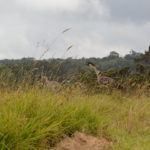Earlier this month, three nēnē including one with a toe injury, the second with a broken leg and a third with an amputated wing, were released into the Hawai‘i Island Nēnē Sanctuary. The three rehabilitated birds have joined a more permanent population of nēnē on a parcel of land that is landscaped just for them and where they can be observed integrating into an existing population and naturally foraging.
The 100-acre sanctuary was originally created to receive 600 Kaua‘i nēnē that were relocated to Hawai‘i Island. Every year hundreds nēnē come to the sanctuary to mate, nest, and prepare their chicks for fledging. When rehabilitated birds arrive at the sanctuary they are banded with a State and federal leg band to help caregivers and researchers keep track of them. Raymond McGuire, a DOFAW wildlife biologist oversees the sanctuary and on arrival day he bands birds and checks their overall health.
Nēnē become used to people, who often try to feed them. Habituation to humans leads to them getting hurt by golf balls, cars, off-leash dogs, and fishing line entanglements.
Photo credit: DLNR
